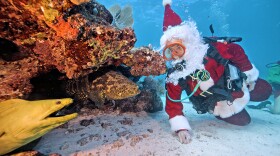The Seminole Tribe of Florida is advocating to save a small island off the mouth of Tampa Bay from eroding.
The island represents a painful moment in the Tribe’s history. It was used as a deportation site in the mid-19th century.
Bobby Henry, cultural adviser to the Seminole Tribe of Florida, says a blessing over the mounds of unmarked graves in a small cemetery on Egmont Key.
“Seminole language. I’ll be using it to talk to God,” he said.
Henry is wearing a red silky patchwork jacket with yellow, black and white stripes, and a matching turban with a large white feather on the front. He has brown buckskin leggings, with light brown tassels just under his knees.

Some of the graves belong to Seminoles. A small list on the fence around the cemetery offers few details as to who they were: Seminole Girl. Died 1857.
They were brought to this island as captives in the 1850s. It was during the Third Seminole War, which pitted the Seminoles against the United States Army.
Chief Justice of the Seminole Courts Willie Johns said some Seminoles were taken captive. Others surrendered.
The Army used Egmont Key as a detainment site. Seminoles would wait there before being sent west to Indian Territory.
“In the writings you read,” Johns said. “They were tattered, they didn’t have much clothes. It wasn’t a good scene. They were starving.”
And while this land was once used as a portal to remove Seminoles from Florida, now the Tribe is campaigning to preserve it.
That’s because Egmont Key is disappearing. Over about 140 years, Egmont Key has shrunk almost in half to 280 acres.
"In the writings you read, they were tattered. They didn't have much clothes. It wasn't a good scene. They were starving." - Chief Justice of the Seminole Courts Willie Johns
Dan Hughes with the U.S. Army Corps of Engineers said erosion here has been going on for a long time. He’s seen it drastically change the shape of the island.
“I’ve seen the beaches, you can see where once there were solid rows of palms and now they're all dead so you're seeing where the shoreline is encroaching further and further into the island,” he said.
The Corps has renourished the beaches in the past.
It’s now consulting with the Seminole Tribe of Florida on a project that would add 39 acres of sand to Egmont Key’s west coast.
The project also includes possibly building an underground 1,500-foot-long wall on the north tip of the island that would hold sand in place.
Still, Hughes said this is a living island, and erosion just happens.
“We're not in control of nature. Nature can throw a lot at us. We can try to the best of our ability to design a fix that will last as long as possible, but as for a permanent fix there’s a lot to contend with here,” he said.
With the Corps looking to change the shape of the island, the Tribe also wants to see what is buried underneath. Representatives are talking with the Florida Bureau of Archaeological Research about finding a noninvasive way to look for anything left behind by captured Seminoles.

Dr. Paul Backhouse, a Seminole tribal historic preservation officer and director of its Ah-Tah-Thi-Ki Museum in Hendry County, said the only records from that time come from the Army and don’t tell the full story of the captive Seminoles.
“At the end of the day we just have manifests and lists of people who were here. They dehumanize what happened on this island. Make no mistake about it: This was a P.O.W. [prisoner of war] camp. Life here would have been incredibly hard,” he said. “Today, it seems like a beautiful paradise. 1857, it was absolutely anything but a beautiful paradise.”
The Tribe wants to bring its history with Egmont Key into the classroom. It’s working on a grant that would create curriculum for kids in the Tampa Bay area and Tribal schools.
It’s also pushing to get Egmont Key added to the National Trust for Historic Preservation’s list of America’s 11 Most Endangered Historic Places.
Back near the cemetery, Seminole cultural advisor Bobby Henry tells a story about how he and a friend went fishing and saw parts of Egmont Key 45 years ago.
When he returned to the island a few years ago, he said some of the land he remembered doesn’t look the same.
“We drive around over there and it’s washed out... We’re not doing anything. We’re not helping,” he said. “And this island is going to be in another 45 years, it’s going to be about a half more gone. We need to talk about it. We need to talk about it.”
The Seminole Tribe of Florida wants to see the island’s history in a fuller light, even as the waters try to make it disappear.








